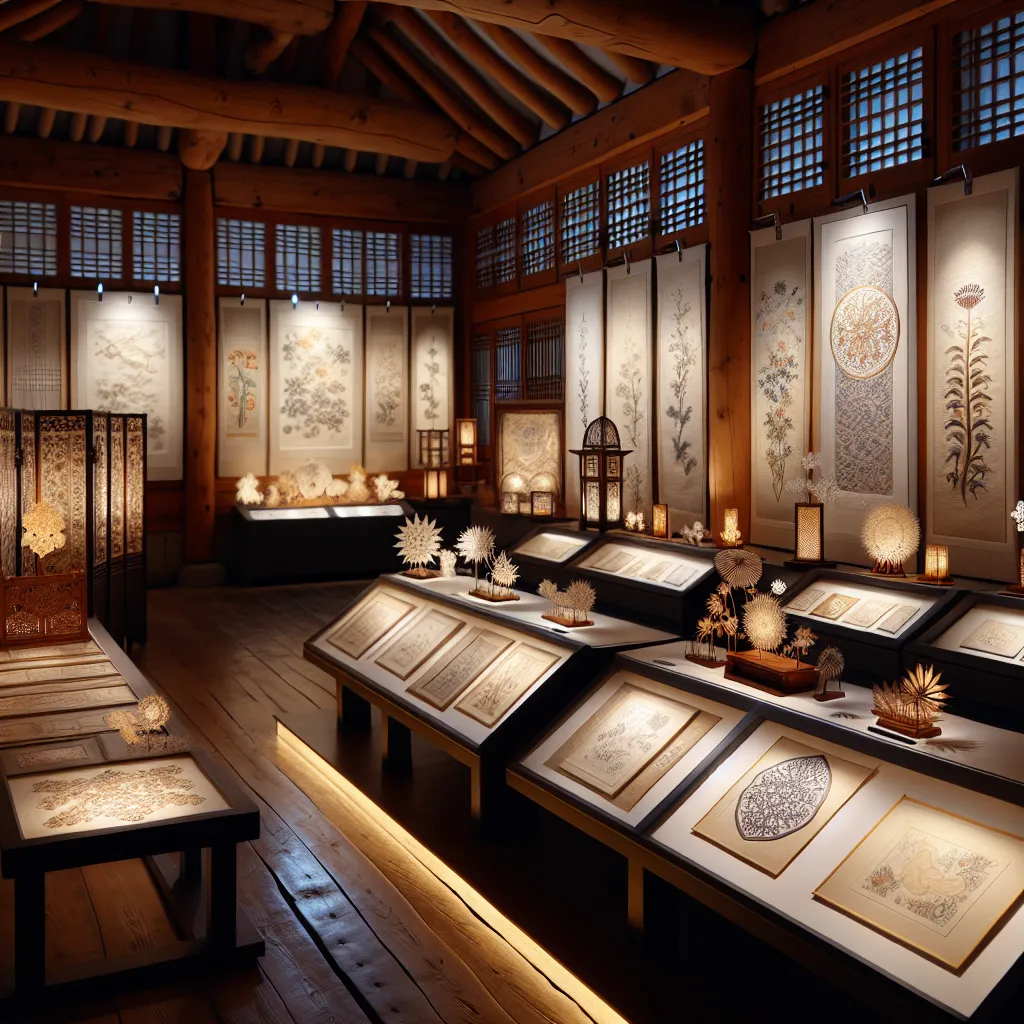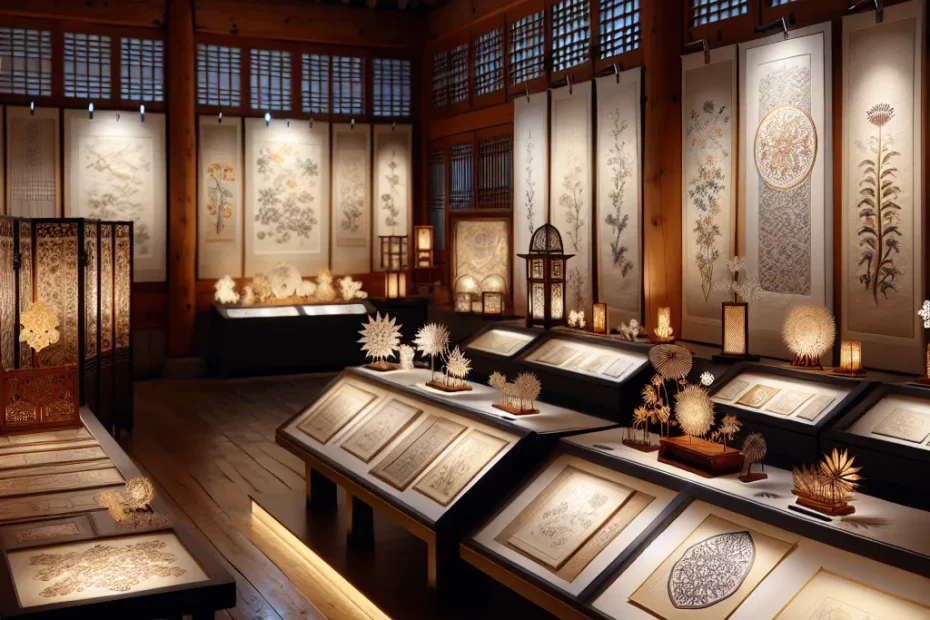In the heart of Jeonju Hanok Village lies a hidden gem – an exhibition showcasing the exquisite art of Hanji crafts. This traditional Korean paper, with its rich history and cultural significance, takes center stage in a display of skill and creativity. As we delve into the techniques and skills demonstrated in the exhibition, we uncover the intricate process behind each handmade masterpiece. The importance of Hanji in Korean culture becomes evident, reflecting a deep connection to heritage and artistry. Moreover, exploring modern innovations in Hanji crafts reveals a harmonious blend of tradition and contemporary design. Join us on a journey through the world of Hanji, where the past meets the present in a celebration of Korean craftsmanship and creativity.

The History of Hanji Crafts in Jeonju Hanok Village
Welcome to the fascinating world of Hanji crafts in Jeonju Hanok Village! Hanji, traditional Korean paper made from mulberry bark, has a rich history dating back over a thousand years. In Jeonju, a city renowned for its preservation of traditional Korean culture, Hanji crafts hold a special place in the hearts of locals and visitors alike.
A Legacy of Craftsmanship
The art of Hanji crafts in Jeonju Hanok Village has been passed down through generations, with artisans honing their skills to create exquisite paper products. From delicate lanterns to intricate window coverings, Hanji is used to craft a wide range of items that showcase the beauty and versatility of this traditional material.
Preserving Cultural Heritage
Hanji crafts play a vital role in preserving Korea’s cultural heritage. In Jeonju Hanok Village, where traditional Korean houses known as hanok line the streets, Hanji is not just a material but a symbol of the city’s commitment to honoring its past. Visitors can explore workshops and exhibitions dedicated to Hanji crafts, gaining a deeper appreciation for the time-honored techniques used to create these masterpieces.
Historical Significance
Hanji has a long history in Korea, with records dating back to the Three Kingdoms period. In Jeonju Hanok Village, this history comes to life as visitors witness artisans using age-old methods to transform raw mulberry bark into beautiful paper. The meticulous process of making Hanji involves steaming, pounding, and drying the bark, resulting in a durable yet flexible material that is perfect for a variety of artistic endeavors.
Artistic Expression
Hanji crafts in Jeonju Hanok Village go beyond mere utility; they are a form of artistic expression. Artisans use Hanji to create stunning pieces that range from traditional paper fans to contemporary sculptures. The natural texture and earthy tones of Hanji add a unique aesthetic to each creation, making it a favorite medium for artists seeking to capture the essence of Korean culture.
Inspiration from Nature
The beauty of Hanji crafts in Jeonju Hanok Village is deeply rooted in nature. The mulberry trees that provide the raw material for Hanji thrive in the fertile soil of Jeonju, symbolizing the connection between the land and the art form. As visitors stroll through the village, they can witness this harmonious relationship firsthand, gaining a deeper understanding of the cultural significance of Hanji in Korean society.
In conclusion, the history of Hanji crafts in Jeonju Hanok Village is a testament to the enduring legacy of traditional Korean papermaking. From its humble origins to its current status as a revered art form, Hanji continues to captivate audiences with its beauty and craftsmanship. So, come and immerse yourself in the world of Hanji crafts, where history, culture, and creativity converge in perfect harmony!
Techniques and Skills Showcased in the Exhibition
The Jeonju Hanok Village Hanji Crafts Exhibition offers a captivating glimpse into the intricate world of traditional Korean paper artistry. Visitors are treated to a showcase of techniques and skills that have been passed down through generations, each piece a testament to the meticulous craftsmanship and artistic vision of the creators.
The Hanji-making Process
From the delicate process of harvesting the mulberry trees to the intricate method of transforming the fibers into paper, every step in the hanji-making process requires precision and expertise. Artisans demonstrate the art of papermaking, showcasing the meticulous handcrafting techniques that result in the creation of durable yet flexible hanji paper.
Jiseung: Traditional Korean Paper Weaving
One of the highlights of the exhibition is the demonstration of jiseung, the traditional Korean paper weaving technique. Visitors are enthralled as skilled artisans deftly weave together strands of hanji to create intricate patterns and designs, showcasing the versatility and strength of this traditional paper medium.
Jidojagi: Korean Paper Marbling
The exhibition also features the art of jidojagi, the intricate process of Korean paper marbling. Visitors marvel at the skillful manipulation of colors and patterns on the surface of water, as artisans carefully transfer the marbled designs onto hanji paper, creating stunning works of art that are both unique and visually captivating.
As visitors explore the exhibition, they are not only immersed in the beauty of hanji crafts but also gain a deeper appreciation for the cultural significance and historical importance of traditional Korean paper art. Each piece on display tells a story of heritage and craftsmanship, inviting visitors to experience the rich artistic legacy that continues to thrive in the heart of Jeonju Hanok Village.
The Jeonju Hanok Village Hanji Crafts Exhibition is a celebration of tradition, innovation, and the enduring legacy of Korean paper artistry. It is a testament to the skill, dedication, and artistry of the artisans who continue to keep this ancient craft alive and thriving in the modern world. Visitors leave the exhibition inspired by the beauty and complexity of hanji crafts, with a newfound appreciation for the techniques and skills that have been showcased in this captivating display of traditional Korean paper art.
Importance of Hanji in Korean Culture
Hanji, traditional Korean paper made from mulberry bark, holds a significant place in Korean culture, reflecting the country’s rich history and artistic heritage. Dating back over a thousand years, Hanji has been an integral part of Korean life, used in various aspects of daily living, art, and traditional ceremonies.
Cultural Significance:
Hanji is not just a material; it embodies the spirit of Korean tradition and craftsmanship. Its production process, involving meticulous handcrafting techniques passed down through generations, highlights the value placed on heritage and authenticity in Korean culture.
Artistic Expression:
Hanji is a versatile medium for artistic expression, used in traditional Korean arts such as calligraphy, painting, and paper folding. The unique texture and durability of Hanji make it a preferred choice for artists seeking to capture the essence of Korean aesthetics.
Historical Legacy:
Throughout Korean history, Hanji has played a crucial role in preserving important documents, books, and artworks. Its durability and resistance to aging make it an invaluable resource for conserving historical records and cultural artifacts.
Ceremonial Use:
Hanji is often used in traditional Korean ceremonies and rituals, symbolizing purity, longevity, and prosperity. From wrapping ceremonial gifts to creating intricate decorations, Hanji adds a touch of elegance and tradition to special occasions.
Literary Heritage:
Hanji has been a medium for literary works, with famous Korean scholars and poets using Hanji to write poems, letters, and manuscripts. The tactile experience of writing on Hanji adds a sensory dimension to the act of storytelling and communication.
Environmental Sustainability:
Hanji‘s eco-friendly production process, using natural materials and traditional methods, aligns with modern principles of sustainability and environmental consciousness. As a renewable resource, Hanji promotes a harmonious relationship between nature and culture.
In conclusion, Hanji transcends its physical form to embody the essence of Korean culture, serving as a symbol of tradition, artistry, and resilience. Its enduring presence in various aspects of Korean life underscores the timeless value of this ancient craft in a rapidly changing world. Let us continue to appreciate and preserve the legacy of Hanji for future generations to cherish and celebrate.
Modern Innovations in Hanji Crafts
In the realm of traditional Korean paper crafts, Hanji stands out as a time-honored art form that has captivated artisans and enthusiasts for centuries. However, in recent years, this ancient craft has seen a resurgence in popularity, thanks to modern innovations that have breathed new life into the age-old techniques.
Integration of Technology
One of the key innovations in Hanji crafts is the integration of technology into the production process. Advanced machinery and equipment have streamlined the manufacturing process, allowing for greater precision and efficiency in creating Hanji paper. This marriage of tradition and technology has not only preserved the authenticity of Hanji but has also opened up new possibilities for creative expression.
Material Experimentation
Furthermore, contemporary artists and designers have been pushing the boundaries of Hanji crafts by experimenting with unconventional materials and techniques. By incorporating elements such as natural dyes, metallic foils, and even recycled paper pulp, artisans are able to create unique textures and patterns that add a modern twist to traditional Hanji pieces.
Innovative Applications
In addition to material experimentation, modern Hanji craftsmen have also been exploring innovative applications for this versatile paper. From intricate sculptures and delicate lanterns to stylish home decor and fashion accessories, Hanji has found its way into various facets of contemporary design, showcasing its adaptability and enduring appeal.
Global Recognition and Collaboration
Moreover, the global recognition of Hanji crafts has led to collaborations between Korean artisans and international designers, resulting in cross-cultural exchanges that further enrich the craft. This blending of traditional Korean aesthetics with modern design sensibilities has not only elevated the status of Hanji on the global stage but has also inspired a new generation of artists to explore the endless possibilities of this ancient art form.
In conclusion, the modern innovations in Hanji crafts have not only revitalized this traditional Korean art form but have also positioned it as a symbol of cultural heritage and artistic innovation. By embracing new technologies, materials, and design concepts, Hanji craftsmen continue to push the boundaries of creativity, ensuring that this ancient craft remains relevant and inspiring for generations to come. 🌟🎨📜
The Jeonju Hanok Village Hanji Crafts Exhibition offers a fascinating glimpse into the rich history and intricate artistry of traditional Korean paper. Through showcasing various techniques and skills, the exhibition highlights the importance of Hanji in Korean culture, emphasizing its cultural significance and artistic value. Moreover, the incorporation of modern innovations in Hanji crafts demonstrates the evolution of this traditional art form, bridging the gap between the past and the present. This exhibition serves as a testament to the enduring legacy of Hanji crafts, inspiring a deeper appreciation for this unique aspect of Korean heritage.
